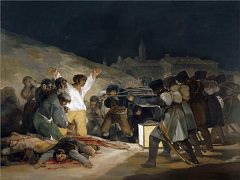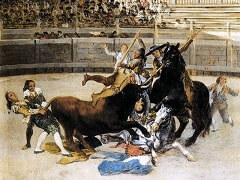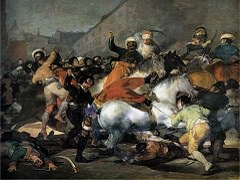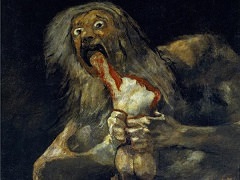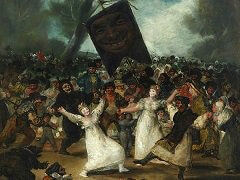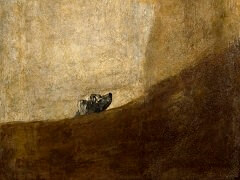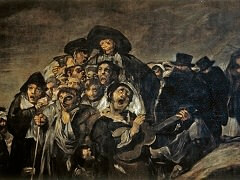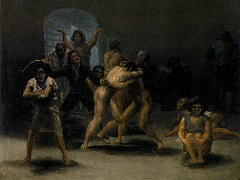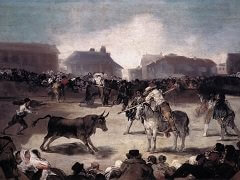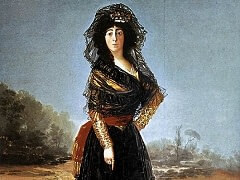Majas on a Balcony, 1800-1810 by Francisco Goya

Majas on a Balcony is one of the many genre paintings by Goya portraying scenes from contemporary life. The physical setting is an azotea or balcony, a characteristic appendage of Spanish houses and an integral part of social life and character in the towns and cities of Goya's country. The features and props of the setting are confined to an iron railing with vertical grills, a very austere structure (compared to the rich elaborate grill-work of which we are accustomed to think as flourishing in Spain.) which alludes to the socio-economic character of the house; the edge of the floor; some chairs - rather inelegant - one of which has cheap wicker matting; and in the background, a bare wall, a only proof of whose presence is a shadow to the extreme right suggesting a material surface.
Four people are portrayed, two young women and two men. In the course of the following paragraphs, observations are offered as to their identities, their stance and the meaning, which the artist wishes to convey through them. Although some degree of speculation is here involved, it is not without logical grounds.
Two young women, presumably Spanish, are attired in the high-waisted, bosom-hugging fashion of the French Empire style, with its characteristic flamboyant accessories. Their elegance is further enhanced by personal adornments - earrings and an unusual number of rings, this last style no doubt, also imported from France, where it was the height of fashion, in the Empress Josephine's salon, to wear rings even on the toes. The lace mantillas, of course, are typically Spanish. The young woman on the left is nudging her companion as if about to say something to her, and the other is bending forward to listen. There is a flippant air about them, even commonness, in spite of the elegance of their attires. They are not aristocratic ladies as their fine apparel may suggest; they lack refinement and dignity, though they are extremely attractive. The artist calls them majas not mujeres. They are no ordinary women. They are courtesans.
And the men at the back, obviously visitors of the establishment, and judging by their garb, military officials, present a marked contrast to the two women. They hover in the background - two shadowy, self-conscious, even sinister figures, their faces only partly revealed. The seated figure turns his head as if to listen to the woman with the black mantilla, though in so doing he keeps his face averted to guard his identity. The other man, who has a mournful expression, uses his scarf to preserve his anonymity. Their mask-like faces recall the grin etchings of Los Descartes de la Guerra and the gloomy Titian paintings.
A closer scrutiny of the painting yields more impressions. The strong contrasts of light and shadow, the restrained use of color, the arrangement of forms, in addition to the attitudes and characters of the people, generate a dramatic mood quite different from the lyricism of, say, Corot's The Letter. One is aware of the disturbing atmosphere of the piece: far from being merely decorative, it is a statement of a serious import. The artist's treatment of his people - the frivolous poses of the women, their pretty but empty faces, the hypocritical attitudes and sheer ugliness of the men - points to the satirical intent of the work. Employing not exaggeration and caricature as Daumier often does, but irony and understatement, Goya makes a subtle criticism on the society of his time. Goya's subtlety as a satirist is perhaps better demonstrated in hid royal portraits where he manages to expose his aristocratic subjects in all their pettiness, artificialities and stupidities without being discovered. In Majas on a Balcony, Goya combines an ironic treatment of material with an impressionistic technique, a mode of presentation, which succeeds in creating a piece of social criticism.

